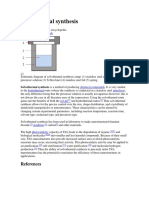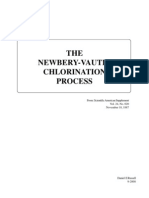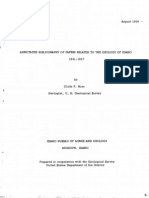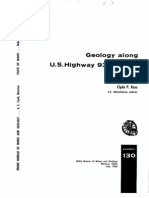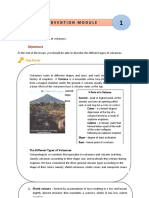Halliday, W. R. PSEUDOKARST IN THE 21 CENTURY PDF
Halliday, W. R. PSEUDOKARST IN THE 21 CENTURY PDF
Uploaded by
CaegeoCopyright:
Available Formats
Halliday, W. R. PSEUDOKARST IN THE 21 CENTURY PDF
Halliday, W. R. PSEUDOKARST IN THE 21 CENTURY PDF
Uploaded by
CaegeoOriginal Title
Copyright
Available Formats
Share this document
Did you find this document useful?
Is this content inappropriate?
Copyright:
Available Formats
Halliday, W. R. PSEUDOKARST IN THE 21 CENTURY PDF
Halliday, W. R. PSEUDOKARST IN THE 21 CENTURY PDF
Uploaded by
CaegeoCopyright:
Available Formats
W.R. Halliday Pseudokarst in the 21st century. Journal of Cave and Karst Studies, v. 69, no. 1, p. 103113.
PSEUDOKARST IN THE 21ST CENTURY
WILLIAM R. HALLIDAY
Hawaii Speleological Survey, 6530 Cornwall Court, Nashville, TN 37205, wrhbna@bellsouth.net
ABSTRACT: Karst is a specific type of terrain (or landscapes) with characteristic suites of
well-known surface and subsurface dissolutional features. The latter result from
integrated subsurface drainage. A variety of nondissolutional processes forms terrains
analogous to certain types of karst; these are termed pseudokarst. Before 1906, these
generally were believed to be karst somehow formed in poorly soluble rocks. They share
a considerable range of features, resources and values with karst, commonly (but not
invariably) including caves, and the two are linked across a wide spectrum of processes
and features (e.g., between dissolutional and piping caves). Unlike karst, integrated
subsurface drainage may not be present. Isolated caves define neither karst nor
pseudokarst. Multiprocess terrains and landscapes are not uncommon. Based largely
on conclusions of a working session of the 1997 International Congress of Speleology,
eight types of pseudokarst are identified, with notably different implications for
extraterrestrial habitats: rheogenic pseudokarst, glacier pseudokarst, badlands and
piping pseudokarst, permafrost pseudokarst, talus pseudokarst, crevice pseudokarst,
compaction pseudokarst and consequent pseudokarst. Some appear to exist on Mars.
Speleologists expert in their differentiation should serve as consultants to planetary
geologists.
INTRODUCTION
The 65th anniversary of the National Speleological
Society also is the 65th Anniversary of the use of the term
pseudokast in the title of a scientific article (Floridia, 1941).
Now, studies of pseudokarst and pseudokarstic caves
constitutes a rapidly expanding subdivision of speleology.
Numerous articles in publications of the National Speleological Society concern pseudokarst and its caves in lava,
in and under glaciers, in seacoasts, in badlands and
landslide topography, crevice caves and terrains in a variety
of rocks, and even multiprocess caves. In part, this trend
has resulted from emphasis on pseudokarst in planetary
geology, but many are fascinating in their own right. The
International Union of Speleology now has a full-fledged
Commission for Pseudokarst as well as another Commission on Volcanic Caves, and a third which maintains
that seemingly pseudokarstic glacier features actually are
karstic, not pseudokarstic.
HISTORY
Landforms now generally recognized as pseudokarstic
were written about in China perhaps 2,300 years ago (Liu
et al., cited by Pewe et al., 1995) and at Italys Mount Etna
only a little later (Carus, T., cited in Banti, 1993). A map of
Icelands Surtshellir system was published in 1759 (Halliday, 2004). During the early 20th Century the term
originated independently in several European languages,
for several types of features and widely varying terrains.
The German geologist von Knebel (1906) appears to have
been the first to use it in print, identifying crevice terrain in
Iceland which engulfs a river as pseudokarstic. Many of
these early writers were far from centers of learning and
were not academics. Commonly their accounts were in
obscure publications. Many were in languages which were
not widely read. Locally invented terminologies tended to
baffle readers, especially those which attempted to apply
karstic concepts to phenomena which only looked karstic.
Beginning around 1927, Russian scientists pioneered
the study of karst-like features in permafrost and in poorly
soluble rocks. In 1931 and 1935 F. P, Savarenskij wrote
about karst-like phenomena in loess and clayey sediments,
terming them loess karst and clay karst (Savarenskij, 1931,
1935 [cited by Alexander Klimchouk, written comm.]). In
1947, N. A. Gvozdetskiy recommended qualified use of the
term pseudokarst, correctly pointing out that its processes
are real, not pseudo. A breakout occurred in mid-century
when central European speleologists began publishing
English-language summaries, then entire papers in English
(e.g., Kukla, 1950; Kunsky, 1957). Vulcanospeleology
developed separately, with initially discrete Italian and
American roots which merged as a result of international
symposia beginning in the 1970s. Initial momentum in
glaciospeleology also had a separate beginning, entirely
European. In July 1886 Forel mapped a newly discovered
250-meter cave in the Arolla Glacier at 1:5000, and
described and discussed it a year later (Forel, 1887). In
1892, a glacial outburst from the Tete-Rousse Glacier
killed some 150 Swiss villagers. The Director of the Mont
Blanc Observatory investigated and found a glacier cave
175 m long leading to a drained glacial lake (Anon., 1892;
Vallot et al., 1892). In 1895 Sieger followed with a lengthy
article entitled Karstformer der Gletscher. It summarizes
several earlier reports of glacier caves in various parts of
the world (Sieger, 1895). Three years later, proceedings of
Journal of Cave and Karst Studies, April 2007 N 103
PSEUDOKARST IN THE 21ST
CENTURY
Figure 1. Rheogenic pseudokarst. Oblique aerial photo of partially collapsed lava tube cave, El Malpais National Monument,
New Mexico. Compare with Figure 7 showing rectilinear crevice pseudokarst.
a symposium on glacial hydrology were published in
Spelunca No. 16.
7)
8)
DEFINITION
Other pseudokarstic types exist (e.g., tower pseudokarst, as discussed by Wray [1997]).
A working session of the 1997 International Congress
of Speleology concluded that pseudokarsts are landscapes
with morphologies resembling karst, and/or may have
a predominance of subsurface drainage through conduittype voids, but lack the element of long-term evolution by
solution and physical erosion (Kempe and Halliday,
1997). Not clearly covered by this definition, however, are
some landscapes arising in talus with an active streamflow
(e.g., Colorados Lost Creek Cave System, discussed
below). An older, simpler definition now seems more
desirable: karst-like morphology primarily produced by
a process other than dissolution.
TYPES OF PSEUDOKARST
On a global basis, the 1997 working session specifically
identified:
1)
2)
3)
4)
5)
rheogenic pseudokarst (pseudokarst on lava flows)
glacier pseudokarst
badland and piping pseudokarst (including loess)
permafrost pseudokarst
talus pseudokarst (including boulder fields and roofed
streamcourses)
Time limitations precluded consideration of two other
important types, and a third is identified here for the first
time:
6) crevice pseudokarst (including littoral pseudokarst)
104 N Journal of Cave and Karst Studies, April 2007
compaction pseudokarst
consequent pseudokarst
RHEOGENIC PSEUDOKARST
Rheogenic pseudokarst includes those portions of lava
flows which are shaped by the presence of open lava tubes
(Fig. 1). Its caves and pits include lava tube caves, hollow
tumuli, hollow lava rises, hollow flow lobes and tongues,
open vertical volcanic conduits, tree and animal mold
caves, hollow hornitos, and a very few hollow dikes.
Spaciousness and near-level floors of numerous terrestrial
lava tube caves suggest that they may be a major
extraterrestrial resource (Halliday, 1966). The Commission
on Volcanic Caves of the International Union of Speleology has taken a proactive approach to identification and
documentation of rheogenic caves and pits throughout the
world, and a global file of maps of lava tube caves is
funded by NASA and maintained at Arizona State
University.
In the last half-century, studies of lava tube caves have
revealed that they are resources scarcely second to
dissolution caves, with many features in common. Some
contain a greater range of minerals than do karstic caves
and some contain biota as specialized as those of karstic
caves and mesocaverns. While significant differences exist
in their hydrogeologic mechanisms, lava tube caves pose
virtually the same disease hazards as dissolution caves. A
few contain cave art, habitations, fossil localities and other
cultural features. Others are notable recreational sites
including show caves.
W.R. Halliday
Figure 2. Glacier pseudokarst. Multiple entrances to the Paradise Ice Cave system ca. 1970.
The longest known lava tube cave is Hawaiis Kazumura Cave which has a slope length of 65.6 km. Never
more than 20 m below the surface, it has a vertical extent
of 1,100 m. Its floor plan basically is sinuous, with local
braiding. It is especially notable for drained plunge pools
up to ,20 m wide. The deepest known open vertical
volcanic conduit is Icelands Thrinukagigur, 204 m deep.
Hawaiis Na One pit crater contains a smaller open vertical
volcanic conduit which begins on a ledge near the bottom
of the pit crater. Their combined depth is 268 m. Divers
have descended 122 m in the water-filled vertical conduit of
Hawaiis Kauhako Center, with the bottom beyond reach
of their lights.
Other volcanic islands with especially notable rheogenic
pseudokarst and caves include Iceland, Honshu (Japan),
Jeju Island (Korea), Azores Archipelago, Canary Islands,
Comoro Archipelago, Galapagos Archipelago, Samoa and
Rapa Nui (Easter Island). Major continental sites include
Italy (Mt. Etna), Kenya and Australia. Other locations
include Syria, Jordan, Saudi Arabia, Rwanda, Chile,
Argentina and Tanzania where a unique carbonatite
rheogenic pseudokarst exists in the crater of Ol Doinyo
Lenggai volcano. In the conterminous United States,
notable rheogenic pseudokarst is present in most of the
states west of the Great Plains (Montana and Wyoming are
exceptions; a single open vertical volcanic conduit recently
was identifield in Nevada, and to date, examples of this
type of pseudokarst in Colorado are minor).
GLACIER PSEUDOKARST
Glaciospeleology is the study of caves and streams
within and beneath glaciers and firn (Fig. 2). Fountain and
Wilder (1998) have provided an excellent overview albeit
with minimal reference to caves. Current studies are
especially active in Iceland, Greenland (especially of
moulins), Svalbard (Spitzbergen), Siberia and southern
South America. Such studies have lagged in Antarctica
where the worlds largest glacier cave either underlies the
Ross Ice Shelf or is the intraglacial cave containing Lake
Vostok. Geothermal caves on Mount Erebus are receiving
increasing study. U.S. Geologic Survey geologist, Israel
Russell, was the father of American glaciospeleology. He
produced several notable reports on the 4,000 km2
(1,500 mi2) Malaspina Glacier in Alaska (e.g., Russell,
1893) with special reference to their caves and hydrogeology. A long hiatus followed Russells work, but additional
glacier pseudokarst was found in Alaska and elsewhere in
the northwestern United States and in the part of British
Journal of Cave and Karst Studies, April 2007 N 105
PSEUDOKARST IN THE 21ST
CENTURY
Columbia bordering the Alaskan panhandle. Aside from
the small, anomalous low-elevation Big Four Ice Caves
(Washington State), the most accessible was on 4,392 meter
Mount Rainier. Its well-known Paradise Ice Caves
originally were in a terminal lobe of its Paradise Glacier.
By 1908 attractive pictures of these caves adorned local
guidebooks. Also, geothermal caves were identified in
craters of several northwestern volcanoes. The largest were
atop Mount Rainier. On Oregons Mount Hood, gas
emissions in such a cave are lethal at least intermittently
(Anonymous, undated, reprinted, 1994a). Geothermal
caves of Mount Baker were found and studied much later.
In the 1940s, the Paradise Ice Caves at the snout of the
Paradise Glacier disappeared as their lobe shriveled and
vanished. A few years later, similar caves were found in the
nearby Stevens Glacier. Through the 1950s and 1960s they
gradually enlarged and the name Paradise Ice Caves was
transferred to them. Also on Mount Rainier, an outburst
flood from a previously unknown cave in the Kautz
Glacier caused considerable damage, but decades passed
before the flood and the new-found cave were correlated.
Much the same happened on Oregons Mount Hood in
1921 (Anonymous, undated, reprinted 1994b).
The year 1968 marked the beginning of a short golden
era of American glaciospeleology centered in the AlaskaBritish Columbia ice fields (e.g., MacKenzie and Peterson,
1968) and on the new Paradise Ice Caves (e.g., Anderson et
al., 1994). In the latter, Anderson and co-workers found
and mapped a total of almost 25 km of ephemeral
passages. These passages appeared, enlarged into spacious
rooms, collapsed and disappeared as this glacier lobe also
shriveled, expanded, shrivelled again and finally disappeared. Maximum length at any given time was 13.25 km
(Anderson et al., 1994). Ice speleothems and glare ice and
firn inclusions in the glacier were especially notable
features. Part of the system reappeared briefly in firn in
the mid-1990s.
In 1970, climbers, cavers and geologists became interested in geothermal ablation caves in the summit craters
of Mount Rainier. Eugene Kiver and co-workers mapped
1.8 km of passages in the east crater and 305 m in the
smaller west crater. It contained a small lake at an altitude
of 4,329 m. Evaluating mudflow hazards, Lokey (1973)
spent 42 consecutive days in these craters and their caves.
Studies of similar, comparatively accessible caves in the
crater of Mount Baker were underway when Mount St.
Helens erupted in 1980. The impact of the eruption
refocused all northwestern speleological activity, and no
further work has been done in the Mount Baker geothermal caves.
BADLANDS AND PIPING PSEUDOKARST
Piping is the horizontal, graded or vertical grain-bygrain removal of particles by channelized ground-water
flow in a granular material and in some poorly soluble
rocks (Fig. 3). Parker and Higgins (1990) and Dunne
106 N Journal of Cave and Karst Studies, April 2007
Figure 3. Gigglers Caves, Kenya, a piping cave in hard
granular tuff.
(1990, p. 128) present different mind-sets and different
vocabularies in the same volume. It long was recognized
primarily as a cause of serious engineering problems. In
recent years, extensive piping caves have become recognized as important individual features. Piping was first
recognized in loess and loess-like silt in China, but natural
caves are not characteristic of loess topography.
The pure form of piping is the pseudokarst extreme of
a speleogenetic spectrum with 100% karstic dissolution at
the other. Between these extremes is an intermediate
interface in impure carbonates and evaporite rocks and
limy sandstones and other poorly soluble rocks. Piping also
participates in development of large multiprocess caves in
some tropical quartzites and in development of compaction
pseudokarst (see below).
Some badlands topography is riddled with pipes, piping
caves, funnel-shaped sinks, dry valleys and other features
of centripetal subsurface drainage commonly observed on
karstic terrains. Locally these form specific landscapes.
Many of their individual features are short-lived; some last
only from one storm to the next. The overall landscape,
however, tends to persist through long periods of scarp
W.R. Halliday
Figure 4. Small room in Officers Cave, Oregon, a piping cave in a pyroclastic landslide. In more consolidated rock with less
frequent rockfall, piping caves may provide extraterrestrial shelter.
retreat. Badlands National Park (South Dakota) is the
American type locality, and Petrified Forest National Park
also contains notable examples. In Oregons John Day
Country, 345-meter Officers Cave (Fig. 4) was described as
an isolated geological curiosity in 1964 (Parker, 1964). A
few years later, Texas and California speleologists began
describing increasingly large, complex piping caves in
a variety of poorly consolidated dry lands. Beginning with
Anvil Points Claystone Cave in 2001, Davis unleashed
a seeming flood of reports on examples in drylands in
western Colorado (e.g., Davis, 2001). Pipes also are
common in boglands, with slutch caves up to 50 m long
reported in England. The longest recorded American
piping cave is 804 m Christmas Canyon Cave, formed in
a thin layer of unconsolidated volcanic ash between
a surficial basalt layer and a mudflow deposit. It serves
as a seasonal resurgence for much of the Cave Basalt lava
flow on the south side of Mount St. Helens, Washington
(Halliday, 2004).
In more consolidated rocks, piping forms complex
caves in sandstones in Minnesota and Arkansas, and
participates in formation of others in hard granular tuff
and in partially soluble lakebed deposits in Kenya. The
latter include Kitum Cave, formerly believed to have been
excavated by elephants seeking salt. Perhaps the longest
piping cave on record is 8 km Bohemia Cave in New
Zealand, said to have been formed largely by ground-water
erosion in phyllites underlying marble.
PERMAFROST PSEUDOKARST
Roughly 10% of the earths surface is underlain by
permafrost. In areas where it is covered by tundra or taiga,
a combination of thawing and piping produces curvilinear
thaw ponds, steep-walled depressions, funnel-shaped pits,
ponors, dry valleys, small caves and other karst-like
features. These are largely of interest as engineering
problems, but Russian and some other geologists have
discussed them specifically as important pseudokarst
features. Somewhat similar features are present where
residual soil of melting glaciers takes the place of tundra or
taiga. In Europe, the term thermokarst has been applied to
permafrost pseudokarst, but there is nothing dissolutional
in the processes which form any of it. Marjorie Sweeting
is among those who have decried this unfortunate term,
pointing out its confusing similarity to thermal karst.
TALUS PSEUDOKARST
Talus caves are receiving increasing attention in the
world speleologic literature, but talus pseudokarst is rarely
mentioned. Nevertheless, talus accumulations occasionally
form important landscapes and American speleologists
tend to underestimate the occurrence and significance of
talus caves per se (Fig. 5). In some parts of Europe, they
are the largest and commonest type of cave. Sjoberg
(1989a) found that 15% of Swedish talus caves have high
scientific and/or recreational values; Swedens Bodagrottorna has more than 2,500 m of passage. In temperate
Journal of Cave and Karst Studies, April 2007 N 107
PSEUDOKARST IN THE 21ST
CENTURY
climates such caves may serve as important glacieres or
provide other microclimates favorable to specialized life
forms. In arid regions, some minimize evaporation of
running or ponded water. Especially in granite and
anorthosite, some provide delightful recreational caving.
A few have been developed as show caves. In Southern
California and probably elsewhere, some talus caves served
as human habitations well into the 20th Century.
In the United States, talus caves exist almost exclusively
in one of two settings: hillside or cliff-bottom rockpile
fields which form talus pseudokarst, and steep-walled
stream gullies. Sjoberg (1989b) also described neotectonic
boulder caves in Sweden. Some of these are end products
of roches moutonnees, smoothed and rounded by glacial
erosion, then fractured by tectonic activity after deglaciation. This combination of processes has preserved the
overall contour of the roche moutonnee, and produced
a localized talus pseudokarst.
Rockpile and rockslide talus caves characteristically are
slope failure features found especially in boulder fields at
the bases of cliffs, on slopes or in narrow stream gorges, or,
rarely, in narrow grabens. A variety of processes is
involved: block glide, grusification of granite, and others.
Some represent a stage of disintegration of crevice caves
affected by differing rates of downslope movement. In
California and in parts of the northeastern United States,
those partially filling narrow, steep-walled granite gorges
are locally termed, purgatory caves. Some of these are
active multiprocess caves, with active vadose solution,
grusification, piping and scouring of talus and bedrock
alike. The alpine Lost Creek system of Colorado has
formed a distinctive narrow dendritic pseudokarst 5 km
long, with large pseudokarstic windows, flat-stacked
boulders and ridges of partially grusified granite up to
60 m high. Here, Lost Creek repeatedly disappears into
swallet caves, reappearing to flow across flat-bottomed
sinkholes (Hose, 1996). Enormous quantities of granitic
sand debris have been cleared from caves and sinkholes in
this unusual system. Smaller examples have been described
in Europe.
Malin and Edgett (2000) have reported several Martian
features resembling certain terrestrial talus pseudokarst.
Some are immediately downslope from presumed outbursts
of water. These are potential Martian glaciers. Others may
serve as small habitation sites.
CREVICE PSEUDOKARST
The first identification of a terrain as pseudokarst
described a crevice pseudokarst in Iceland (von Knebel,
1906). Where karst and karstic caves are readily
accessible, however, all but the most spectacular crevice
caves and crevice pseudokarst (e.g., Fingals Cave, Island
of Staffa, Scotland) are commonly ignored. Consequently
they are much more common than is generally recognized. They occur in both littoral and inland terrains; the
former includes littoral zones of now-dry inland Pleisto108 N Journal of Cave and Karst Studies, April 2007
Figure 5. Talus pseudokarst at Pottstown, Pennsylvania.
Because the general public is more interested in talus caves
than are speleologists, old postcards are a useful resource in
identifying them.
cene lakes. Littoral examples are formed by hydraulic
wedging by waves and other forms of marine erosion.
These may form fractures extending hundreds of meters
inland, readily traceable on the surface (Fig. 6). Especially where sinkholes develop along such fractures, small
but interesting pseudokarstic landscapes may be identified. Examples include the island of Staffa, Scotland, the
Ballybunion coastal area of Ireland, sections of the
Oregon coast including the Devils Punchbowl and the
area of Sunset Cliffs, San Diego County, California.
Because of their origin and geometry, few such caves are
inhabitable.
Inland crevice caves vary greatly in size. A few have
extraordinary parameters, such as Devils Hole in the small
Nevada section of Death Valley National Park. The small
near-surface section of this feature is complex and karstic,
but most of it consists of a single spacious crevice in
W.R. Halliday
Figure 6. Littoral crevice pseudokarst, island of Staffa, Scotland. The right hand opening is the entrance to Fingals Cave.
limestone occupied by warm ground water apparently
much more than 100 m deep (the National Park Service
prohibits cave diving here). It apparently formed as a result
of structural tension in the Great Basin and its water is part
of a major regional aquifer (Riggs et al., 2000).
Smaller inland crevice caves vary from isolated cracks
in cliffs to narrow rectilinear networks on slopes. Many
of the latter are an intermediate stage of breakup of
competent rock masses due to mass movement or gravitysliding enhanced by local subsurface drainage. Where the
movement is not uniform across the length of such a crevice,
bedrock blocks slide and rotate at different speeds and in
different directions, converting part or all of crevice caves
into one or more talus caves. Basalt and granite commonly
develop curvilinear crevice caves rather than rectilinear
forms. Some deep caves in tropical quartzite are crevice
caves, but others are multiprocess caves extensively modified
by piping. Crevice terrains in Arizona appear to be of one
of two types. Some in northern Arizona are believed to be
the product of subsidence caused by deeply buried karst.
Others in areas of especially deep alluvium appear to be the
result of excessive drawdown of ground water (Harris and
Allison, 2006). Tectonic and solutional caves occur along the
former.
Most of the island of Hawaii lacks surface drainage as
a result of crevice pseudokarst formed as a result of
fractures in brittle basalts secondary to various volcanic
and seismic events. Most of these crevices are concealed by
vegetation or by volcanic ash, or by subsequent lava flows.
But the Great Crack in the southwest rift zone of Kilauea
volcano is a kilometer-wide zone of en echelon crevices of
various widths and depths, locally open to the surface
(Figs. 7 and 8). An implausible concept of its origin is that
the weight of Kilauea volcano is tilting that part of the
island of Hawaii away from Mauna Loa volcano, and that
Kilauea volcano ultimately will slide or topple into the
Pacific Ocean. More plausible is the possibility that this is
a self-propagating crevice, enlarged and elongated by
injection of pressurized magma into initially small fractures
in the wall of Halemaumau crater. Within it, mapping
teams have reached a depth of 183 m. At several levels, one
or more lateral coatings or lava reveal lateral flow of lava
at depth. The Great Rift of south central Idaho is another
very large inland crevice in a basalt flow field (Fig. 9). At
least one eruptive fracture on Mount Etna (Italy) extends
downslope in the form of a lava tube cave (Giudice and
Scalia, 1994).
Unless block glide has been active, crevice caves
characteristically taper downward. Localized floors generally are formed by wedged breakdown blocks. Thus
extraterrestrial crevice caves are unlikely to be suitable
habitation sites.
COMPACTION PSEUDOKARST
Compaction is common in landslide and avalanche
deposits. This facilitates piping (see above). Pseudokarst
may be formed by such compaction, and is discussed here
for the first time. Initially, drainage of such deposits tends
to be internal and their surfaces may be pitted with large
and small punched out or conical crater-like depressions
(Fig. 10). A notable example formed in unconsolidated
material at the northern base of Mount St. Helens
(Washington State) on May 18, 1980. Here, virtually the
entire northern side of the volcano avalanched moments
Journal of Cave and Karst Studies, April 2007 N 109
PSEUDOKARST IN THE 21ST
CENTURY
Figure 7. Crevice pseudokarst in a 2 km segment of the Southwest Rift Zone of Kilauea Volcano, Hawaii. Individual pits
along the Great Rift are lettered from north to south; Pit H is near the center of the photo. It has been mapped to a depth of
186 m. Note that smaller en echelon crevices are mostly hidden by vegetation.
110 N Journal of Cave and Karst Studies, April 2007
W.R. Halliday
withstand the impact of large rocks which sometimes
broke loose and rolled down the steep slope of the closed
depression. The resulting orifice revealed muddy water in
a low cavern roofed by the quicksand layer.
Overall, this pseudokarst evolved rapidly. With each
seasonal rain, the surface of the ponds rose disproportionately as the ash cloud deposit washed into them. Surface
drainage developed, and all but the largest depressions
disappeared within 15 years. After 25 years the area still
could be recognized as pseudokarstic.
In southern Nevada and adjacent Utah, several small
caves and pits have been identified in alluvium including
Alluvium Cave. Some, but not all, are the result of piping.
CONSEQUENT PSEUDOKARST
Consequent pseudokarst is karst-like terrains resulting
from action of natural processes on shallow mines,
underground quarries and other subsurface works of
man. Although the U.S. Geological Survey has studied
many such occurrences, the term and the unifying concept
were developed late in the 20th Century by Istvan Eszterhas
of Hungary. Some of the affected areas contain extensive
caverns formed by natural stoping, bounded on all sides by
talus or by fracture surfaces. Their surface features tend to
be rectilinear, and they commonly cause serious engineering problems. Underground drainage is minimal or absent.
THE FUTURE OF PSEUDOKARST
Figure 8. A short segment of the Great Rift, Idaho, seen
from a large skylight. The flat is an artificial pathway
constructed to permit visitor access.
before a lateral ash-cloud eruption covered its slump with
several meters of slightly cohesive volcanic sand. The
avalanche layer contained large and small fragments of
fractured glaciere as well as shattered blocks of bedrock.
Some were transported laterally for several kilometers in
their original upright position. All was heated, but the
degree of hydrothermal injection varied. Almost at once,
melting and compaction began to generate crateriform and
punched-out depressions varying widely in size.
The overlying ash cloud deposit underwent rapid
erosion, with formation, enlargement and headward erosion
of new gullies followed by coalescence of closed depressions
and pond formation. During the first few months, vertical
piping was prominent locally. As gullies enlarged, deepened
and pirated their neighbors, parallel crevices formed in the
pyroclastic ash cloud sand, elongating up-slope. Some were
partially roofed by block slumping, and piping developed
along their bases. More extensive roofing formed a few
short-lived pyroclastic caves.
A 1 m layer of quicksand atop one temporary pond
supported the weight of investigators, but did not
Despite 20th Century progress in this rapidly emerging
field, documentation and study of pseudokarst inevitably
has lagged behind those of karst. Application of hardlearned calcareospeleological exploration techniques to
some volcanic pseudokarst, however, has shown that many
long-established techniques are easily modified to meet new
conditions as needed (e.g., hyperthermal, hypothermal,
hypoxic, and hypercarbic caves).
If this is to be mans century of breakout into space,
speleologists everywhere need to stay alert to the great
volume of relevant data now pouring back from Mars and
beyond, and to volunteer our assistance in the interpretation of data already seen to demonstrate confusingly varied
terrains. This is an area of progressively narrow specialization and we cannot expect planetary geologists, or even
terrestrial geologists lacking in experience with various
types of terrestrial pseudokarst, to recognize and properly
utilize their extraterrestrial analogues. Already on Mars,
what appears to be a typical crevice cave has been
identified as a potentially habitable lava tube. Plans relying
heavily on such misidentifications open the way to disaster.
Perhaps the first step should be breaking down the
language barrier which still hinders definitive communication between central European pseudokarst specialists and
those of the rest of the world. If necessary, travel to a series
of international meetings on pseudokarst should be
subsidized. The National Speleological Society and the
Journal of Cave and Karst Studies, April 2007 N 111
PSEUDOKARST IN THE 21ST
CENTURY
Figure 9. Landing created by wedging of rockfall, the Great Crack, Hawaii. Terrestrial caves of this type are unsuitable for
human habitation.
Figure 10. Subsidence pseudokarst. This conical depression in the Spirit Lake pseudokarst (Mount St. Helens, Washington
State) was photographed in an early stage of its evolution. A thin ash-cloud tephra deposit is still present on the flats formed on
top of the landslide deposit containing the sinkhole.
112 N Journal of Cave and Karst Studies, April 2007
W.R. Halliday
International Union of Speleology should take the lead in
such endeavors. The survival of man in space may depend
on it.
ACKNOWLEDGEMENTS
The author would like to thank Jan Paul van der Pas for
the oblique photograph that appears in Figure 6 and Chris
Okubo for the 1988 NASA photograph that appears in
Figure 7.
REFERENCES
Anonymous, 1892, (untitled), Nature, v. 46, no. 1192, p. 420.
Anonymous, undated 1994a (reprinted), Deadly furmaroles always
intriguing: Bulletin of the International Glaciospeleological Survey,
v. 6, p. 3031.
Anonymous, undated, 1994b (reprinted), Pioneers witnessed Hoods
volcanic fire: Bulletin of the International Glaciospeleological Survey,
v. 6, p. 3132.
Anderson, C.H., Vining, M.R., and Nichols, C.M., 1994, Evolution of
the Paradise/Stevens Glacier Ice Caves: Bulletin of the National
Speleological Society, v. 56, no. 2, p. 7081.
Banti, M., ed., 1993, Proceedings of the International Symposium on the
Protohistory of Speleology, Citta di Caseello (Italy), Prhomes.
Davis, D., 2001, Anvil Points Claystone Cave Complex: An exceptionally
large mud cave system: National Speleological Society News, v. 59,
no. 11, p. 331334.
Dunne, T., 1990, Hydrology, mechanics and geomorphological implications of erosion by subsurface flow, in Groundwater geomorphology:
The role of surface water in earth-surface processes and landforms,
Higgins, C.G., and Coats, D.R., eds., Geological Society of America
Special Publication 252.
Floridia, G., 1941, Un particolare fenomeno pseudocarsico manifestato da
algune argile: Bolletino della Societa ei Sciencia Naturale ed
Economiche di Palermo, v. 23, p. 1019.
Forel, F.A., 1887, Etudes Glaciares: II, La grotte naturale du Glacier
dArolla: Archives des Sciences Physiques et Naturale (Geneva),
Troisieme Periode, tome xvii, no. 5, p. 469504.
Fountain, A., and Wilder, J., 1998, Water flow through temperate glaciers:
Reviews of Geophysics, v. 36, no. 3, p. 294.
Guidice, G., and Scalia, N., 1994, La frattura eruttiva di Profundo-Nero:
Bolletino della Accademia Gioeni di Scienze Naturali, v. 27, no. 348,
p. 161171.
Halliday, W.R., 1966, Terrestrial pseudokarst and the lunar topography:
Bulletin of the National Speleological Society, v. 28, p. 167170.
Halliday, W.R., 2004, Pseudokarst, in Encyclopedia of caves and karst
science, Gunn, J., ed., London, G.B., Fitzroy Dearborn (an imprint of
Taylor & Francis Books, Inc.), p. 604608.
Harris, R., and Allison, M.L., 2006, Hazardous cracks running through
Arizona: Geotimes, p. 2427.
Hose, L., 1996, The Lost Park Reservoir Project, Park County, Colorado,
in Kolstad, R., ed., The caves and karst of Colorado: 1996 National
Speleological Society Convention Guidebook.
Kempe, S., and Halliday, W.R., 1997, Report on the discussion on
pseudokarast, in Proceedings of the 12th International Congress of
Speleology, v. 6, Basel, Switzerland, Speleoprojects.
Kukla, J., 1950, Pseudokrasove jeskyne u Lotu no Sokolovsku,
Ceskoslovensky Kras, v. 3, p. 274278.
Kunsky, J., 1957, Types of pseudokarst phenomena in Czechoslovakia,
Ceskoslovensky Kras, v. 10, no. 3, p. 111125.
Lee, F.T., and Abel, J.F., 1983, Subsidence from underground mining:
Environmental analysis and planning considerations, U.S. Geological
Survey Circular 876.
Lokey, W.M., 1973, Crater studies on a sleeping volcano: Explorers
Journal, v. 51, no. 3, p. 167170.
Malin, M., and Edgett, K., 2000, Evidence for recent groundwater seepage
and surface runoff on Mars: Science, v. 288, p. 2,3302,335.
McKenzie, G.D., and Peterson, D.W., 1968, Observations of a glacier
cave in Glacier Bay National Monument, Alaska: Bulletin of the
National Speleological Society, v. 30, no. 3, p. 4754.
Parker, G., 1964, Officers Cave, a pseudokarstic feature in altered tuff and
volcanic ash in the John Day formation in eastern Oregon: Geological
Society of America Bulletin, v. 75, p. 393401.
Parker, G., and Higgins, C., 1990, Piping and pseudokarst in drylands, in
Higgins, C.G., and Coates, D.R., eds., Groundwater geomorphology:
The role of subsurface water in earth-surface processes and landforms:
Geological Society of America Special Paper 252.
Pewe, T., Liu, T., Slatt, R.M., and Li, B., 1995, Origin and characteristics
of loess-like silt in the southern Qinghai-Xizang (Tibet) Province,
China: U.S. Geological Survey Professional Paper 1549.
Riggs, A.C., Winograd, I.J., Carr, W.J., Kolesar, P.T., and Hoffman, R.J.,
2000, Devils Hole, a tectonic cave in southern Nevada with
a continuous 0.5 million-year-long paleoclimate record, in Levich,
R.A., Linden, R.M., Patterson, R.L., and Stuckless, J.S., eds.,
Hydrologic and geologic characteristics of the Yucca Mountain site
relevant to the performance of a potential repository: Geological
Society of America Field Guide 2, p. 387392.
Russell, I.C., 1893, Malaspina Glacier: Journal of Geology, v. l, no. 1,
p. 1137.
Sieger, R., 1895, Karstformer der gletscher: Hellners Geographische
Zeitschrift, v. 1, p. 182204.
Sjoberg, R., 1989a, Caves as indicators of neoteconics in Sweden, in
Proceedings, 2nd Symposium on Pseudokarst, Janovicky near
Broumova, 1985, Prague, Czech Speleological Society.
Sjoberg, R., 1989b, An inventory of caves in the county of Vesternorrland,
northern Sweden, in Proceedings, 2nd Symposium Pseudokarst,
Janovicky near Broumova, 1985, Prague, Czech Speleological Society.
Vallot, M.J., Delebecque, A., and DuParc, L., 1892, La catastrophe du
Saint-Gervais 12 Juillet 1892: Archives des Sciences Physiques et
Naturales, Geneva, Troisieme Periode, v. 28, p. 179201.
von Knebel, W., 1906, Hohlenkunde mit Berucksichtigung der Karstphanomene, Braunschweig, Germany, Druck und Verlag von Freidrich
Vieweg und Sohn, p. 183.
Wray, R.A.L., 1997, A global review of solutional weathering forms on
quartz sandstones: Earth Science Review, v. 47, p. 137160.
Journal of Cave and Karst Studies, April 2007 N 113
You might also like
- Gemstones of Western AustraliaDocument64 pagesGemstones of Western AustraliawicksyjrNo ratings yet
- STORYWORKS Volcano Nonfiction TextEvidence LLDocument2 pagesSTORYWORKS Volcano Nonfiction TextEvidence LLSarah LawtonNo ratings yet
- Tertiary ChannelsDocument6 pagesTertiary ChannelsMarc LightNo ratings yet
- Melting Pour Aluvian GoldDocument2 pagesMelting Pour Aluvian GoldRosinaldo Araújo LimaNo ratings yet
- Three Kinds of RocksDocument4 pagesThree Kinds of RocksTitser Rock SonNo ratings yet
- HIDROTERMALDocument8 pagesHIDROTERMALMariel SanchezNo ratings yet
- Placergoldmininginalaska 18feb15 151008105142 Lva1 App6891Document101 pagesPlacergoldmininginalaska 18feb15 151008105142 Lva1 App6891REandoNo ratings yet
- Platinum Group Elements in Sedimentary EDocument49 pagesPlatinum Group Elements in Sedimentary EOuchy100% (1)
- Vautin ProcessDocument4 pagesVautin ProcessAFLAC ............No ratings yet
- Goldrecoveryfromarefractory Ore From Zealand: J.G. Dunnl and J Graham2Document8 pagesGoldrecoveryfromarefractory Ore From Zealand: J.G. Dunnl and J Graham2Simon ThaiNo ratings yet
- ESS 212 Lab Plutonic RocksDocument12 pagesESS 212 Lab Plutonic RocksSeptianYogaPratamaNo ratings yet
- Geology of Sudbury BasinDocument44 pagesGeology of Sudbury BasinburhanudinNo ratings yet
- Gold Dore BarsDocument2 pagesGold Dore BarsdaelingNo ratings yet
- Report On Buckley Mine, Provo, Utah, 1907-James FlintDocument4 pagesReport On Buckley Mine, Provo, Utah, 1907-James FlintiamsquatNo ratings yet
- Suitcase DredgeDocument21 pagesSuitcase DredgeChris Findley100% (1)
- The Helical Flow EffectDocument15 pagesThe Helical Flow Effectjeffradford9138No ratings yet
- Tri State Minerals A Basic GuideDocument7 pagesTri State Minerals A Basic GuideChristopher WisemanNo ratings yet
- Quick Assays in Mineral IdentificationDocument88 pagesQuick Assays in Mineral IdentificationAFLAC ............No ratings yet
- Gold Recovery CellDocument5 pagesGold Recovery Celloctrom100% (1)
- Navigation Search Element 79 (Anthology) Gold (Color) Gold (Disambiguation)Document45 pagesNavigation Search Element 79 (Anthology) Gold (Color) Gold (Disambiguation)Ayaz Saa'irNo ratings yet
- Clay MineralsDocument17 pagesClay Mineralsyash saragiyaNo ratings yet
- Gneiss Metamorphic Rock Pictures Definition MoreDocument4 pagesGneiss Metamorphic Rock Pictures Definition MoreElton LopezNo ratings yet
- p-119 Biblio Id Geology 1941 1957Document222 pagesp-119 Biblio Id Geology 1941 1957Russell HartillNo ratings yet
- 2016-Catalog Keene Engineering PDFDocument44 pages2016-Catalog Keene Engineering PDFZuwairi NawawiNo ratings yet
- Potential Geologic in JordanDocument14 pagesPotential Geologic in JordanSteven TremolNo ratings yet
- REFINEIT-10F Fumeless Electrolytic Gold and Silver Refining System. 0.5 Kilo Per DayDocument2 pagesREFINEIT-10F Fumeless Electrolytic Gold and Silver Refining System. 0.5 Kilo Per DayBharata BadranayaNo ratings yet
- Dysons Bus Lines TimetableDocument22 pagesDysons Bus Lines TimetableHOTDAWG HOOMAANNo ratings yet
- IndexDocument2 pagesIndextravellerfellowNo ratings yet
- Borax Replacing Mercury in Small Scale MiningDocument3 pagesBorax Replacing Mercury in Small Scale MiningAFLAC ............No ratings yet
- About Igneous RockDocument14 pagesAbout Igneous RockThia BummiesNo ratings yet
- Southern Rocky Mountain and Colorado Mid-Tertiary Impact EventDocument39 pagesSouthern Rocky Mountain and Colorado Mid-Tertiary Impact EventTim McElvain100% (1)
- Long Tom SluiceDocument6 pagesLong Tom SluiceJovanny HerreraNo ratings yet
- Ore Deposits GoldDocument12 pagesOre Deposits Goldfelipe4alfaro4salasNo ratings yet
- Getting Gold: a practical treatise for prospectors, miners and studentsFrom EverandGetting Gold: a practical treatise for prospectors, miners and studentsNo ratings yet
- Channeled Scablands (Baker 1978)Document205 pagesChanneled Scablands (Baker 1978)PaleogeneNo ratings yet
- Sluice Combo: (An Inexpensive Way To Start Out Prospecting)Document9 pagesSluice Combo: (An Inexpensive Way To Start Out Prospecting)Engku Mohd Ridzuan Tuan YunusNo ratings yet
- Understanding Gold - (Silver) - Telluride - (Selenide) Mineral Deposit PDFDocument15 pagesUnderstanding Gold - (Silver) - Telluride - (Selenide) Mineral Deposit PDFromanangelhernandez100% (2)
- Oregon Geology Vol 61Document152 pagesOregon Geology Vol 61Edwin100% (1)
- Mineralization Characteristics of Ajibarang Gold Prospect, Purwokerto, Central Java: A "Carbonate Base Metal"-Gold SystemDocument9 pagesMineralization Characteristics of Ajibarang Gold Prospect, Purwokerto, Central Java: A "Carbonate Base Metal"-Gold SystemDoko SubagyoNo ratings yet
- Sedimentary Rock IdentificationDocument4 pagesSedimentary Rock IdentificationGilang Putra BahanaNo ratings yet
- Extremophiles - RTB 11.3Document43 pagesExtremophiles - RTB 11.3raanja2100% (1)
- Flux MethodDocument3 pagesFlux MethodRekhaNo ratings yet
- Wyoming sMineralWealth May2008Document57 pagesWyoming sMineralWealth May2008azamshafiq100% (1)
- Spanish Conquest-Treasure HuntingDocument6 pagesSpanish Conquest-Treasure Huntingapi-305531023No ratings yet
- p-130 Geology Along Highway 93 in Id 1963Document119 pagesp-130 Geology Along Highway 93 in Id 1963Russell HartillNo ratings yet
- Recovery of Gold From Balbach-Thum Slimes at Copper CliffDocument5 pagesRecovery of Gold From Balbach-Thum Slimes at Copper Cliffedisanila100% (1)
- Models For Volcanic-Hosted Epithermal Precious Metal Deposits A ReviewDocument11 pagesModels For Volcanic-Hosted Epithermal Precious Metal Deposits A ReviewOrlando B Santa Cruz100% (1)
- New Constraints On The Chemistry of Magmas and Fluids Associated With Intrusion-Related Gold DepositsDocument9 pagesNew Constraints On The Chemistry of Magmas and Fluids Associated With Intrusion-Related Gold DepositsedovempNo ratings yet
- Chemistry of Colored GlassDocument3 pagesChemistry of Colored GlassFirst LastNo ratings yet
- Iodine Clock ReactionDocument2 pagesIodine Clock ReactionDina Mohd HalidiNo ratings yet
- A Geochemical Classification For Granitic RocksDocument16 pagesA Geochemical Classification For Granitic RocksFitrah HaidirNo ratings yet
- Afftech Abstract Manual 10000pc AutomatedDocument50 pagesAfftech Abstract Manual 10000pc AutomatedAFLAC ............100% (1)
- Magmatic DifferentiationDocument6 pagesMagmatic DifferentiationEbenezerSherlockAyiteyNo ratings yet
- Secret Lives of MineralsDocument11 pagesSecret Lives of MineralsJames 'jps' SimanjuntakNo ratings yet
- Breccia and Vein Mineralization of The Balatoc DiaDocument15 pagesBreccia and Vein Mineralization of The Balatoc DiaLeoniwin Keith Serrada100% (1)
- Epithermal Gold Deposits (Mineral Resources Dept. GSJ)Document2 pagesEpithermal Gold Deposits (Mineral Resources Dept. GSJ)blackNo ratings yet
- WHITE, W. B. Paleoclimate Records From Speleothems in Limestone CavesDocument41 pagesWHITE, W. B. Paleoclimate Records From Speleothems in Limestone CavesCaegeoNo ratings yet
- Shofner, Gregory A. and Mills, Hugh H. A Simple Map Index of Karstification and Its Relationship To Sinkhole and Cave Distribution in Tennessee PDFDocument9 pagesShofner, Gregory A. and Mills, Hugh H. A Simple Map Index of Karstification and Its Relationship To Sinkhole and Cave Distribution in Tennessee PDFCaegeoNo ratings yet
- KLIMCHOUK, Alexander. Unconfined Versus Confined Speleogenetic Settings, Variations of Solution PorosityDocument7 pagesKLIMCHOUK, Alexander. Unconfined Versus Confined Speleogenetic Settings, Variations of Solution PorosityCaegeoNo ratings yet
- White - Conceptual Models For Karstic AquifersDocument6 pagesWhite - Conceptual Models For Karstic AquifersCaegeoNo ratings yet
- Wooldridge, S. W. e East, W. G. An Introduction To Human Geography PDFDocument200 pagesWooldridge, S. W. e East, W. G. An Introduction To Human Geography PDFCaegeoNo ratings yet
- KLIMCHOUK, Alexander B. Hypogene SpeleogenesisDocument29 pagesKLIMCHOUK, Alexander B. Hypogene SpeleogenesisCaegeoNo ratings yet
- Klimchouk, A. & Ford D. Hypogene SpeleogenesisDocument15 pagesKlimchouk, A. & Ford D. Hypogene SpeleogenesisCaegeoNo ratings yet
- History of Caving in IranDocument3 pagesHistory of Caving in IranCaegeo100% (1)
- Jagnow, David H. History of The Sulfuric Acid Theory of Speleogenesis in The Guadalupe Mountains, New MexicoDocument6 pagesJagnow, David H. History of The Sulfuric Acid Theory of Speleogenesis in The Guadalupe Mountains, New MexicoCaegeoNo ratings yet
- Jagnow, David H. History of The Sulfuric Acid Theory of Speleogenesis in The Guadalupe Mountains, New MexicoDocument6 pagesJagnow, David H. History of The Sulfuric Acid Theory of Speleogenesis in The Guadalupe Mountains, New MexicoCaegeoNo ratings yet
- SASOWSKY, I. D. Clastic Sediments in Caves - Imperfect Recorders of Processes in KarstDocument8 pagesSASOWSKY, I. D. Clastic Sediments in Caves - Imperfect Recorders of Processes in KarstCaegeoNo ratings yet
- MEEK, P. D. The History of Christmas Island and The Management of Its Karst FeaturesDocument6 pagesMEEK, P. D. The History of Christmas Island and The Management of Its Karst FeaturesCaegeoNo ratings yet
- KASTNING, Ernst H. KASTNING, Karen M. Misconceptions About Caves and Karst, Common Problems and Educational SolutionsDocument9 pagesKASTNING, Ernst H. KASTNING, Karen M. Misconceptions About Caves and Karst, Common Problems and Educational SolutionsCaegeoNo ratings yet
- KRANJC, Andrej Baltazar Hacquet (1739!40!1815), The Pioneer of Karst GeomorphologistsDocument6 pagesKRANJC, Andrej Baltazar Hacquet (1739!40!1815), The Pioneer of Karst GeomorphologistsCaegeoNo ratings yet
- Past Paper 1Document20 pagesPast Paper 1theaw940No ratings yet
- Volcano WebquestDocument3 pagesVolcano WebquestMaria Fe IgnacioNo ratings yet
- Unit 5 - Hawaii Volcanoes National ParkDocument3 pagesUnit 5 - Hawaii Volcanoes National ParkDaniel ChioseauaNo ratings yet
- English For Tet HolidayDocument24 pagesEnglish For Tet HolidayTuệ MinhNo ratings yet
- SW13 ScientificProgramDocument154 pagesSW13 ScientificProgramJim ZhangNo ratings yet
- National Geographic Traveler - December 2015, January 2016Document100 pagesNational Geographic Traveler - December 2015, January 2016prism1702100% (2)
- How To Recognize Where A Volcano Will EruptDocument7 pagesHow To Recognize Where A Volcano Will EruptPepay DisomangcopNo ratings yet
- (Reaktion Books - Earth) James Hamilton - Volcano - Nature and Culture-Reaktion Books (2012)Document210 pages(Reaktion Books - Earth) James Hamilton - Volcano - Nature and Culture-Reaktion Books (2012)Rokhmin Dahuri InstituteNo ratings yet
- 2021 HSC Earth and Environmental ScienceDocument38 pages2021 HSC Earth and Environmental ScienceCourtney.RansonNo ratings yet
- The Wall Street Journal December 24, 2024@MagazinesclubnewDocument25 pagesThe Wall Street Journal December 24, 2024@MagazinesclubnewpapercitypenneyywqsfNo ratings yet
- 04 Hawaii VolcanoesDocument26 pages04 Hawaii VolcanoesJobanie AmadhayNo ratings yet
- 65 Nov 2012Document23 pages65 Nov 2012jordiNo ratings yet
- Kilauea Iki Trail Guide 2013Document20 pagesKilauea Iki Trail Guide 2013api-285021878No ratings yet
- Study Pack 1Document6 pagesStudy Pack 1NADEESHA FERNANDONo ratings yet
- 05-11-18 EditionDocument32 pages05-11-18 EditionSan Mateo Daily JournalNo ratings yet
- Apolaki - The Largest Volcano in The PhilippinesDocument5 pagesApolaki - The Largest Volcano in The PhilippinesJustin Paul VallinanNo ratings yet
- Volcanic Eruptions Impacts Student WorksheetDocument4 pagesVolcanic Eruptions Impacts Student WorksheetOlivia WiyanaNo ratings yet
- Atestat EnglezaDocument28 pagesAtestat EnglezaOcti627124No ratings yet
- Learn at Home Grade 2Document66 pagesLearn at Home Grade 2Office of eLearning Services100% (3)
- Geo HazardsDocument157 pagesGeo HazardsEducated IdiotNo ratings yet
- Volcano Unit Plan FinalDocument9 pagesVolcano Unit Plan FinalMialyn S. CañeteNo ratings yet
- BulkanoDocument17 pagesBulkanoKirby MalibiranNo ratings yet
- Intervention Module: CompetencyDocument3 pagesIntervention Module: CompetencyJan IceNo ratings yet
- Geological Engineering Reconnaissance of Damage Caused by The October 15Document48 pagesGeological Engineering Reconnaissance of Damage Caused by The October 15Tony ChanNo ratings yet
- VolcCh5 Wicander-PhysG PDFDocument36 pagesVolcCh5 Wicander-PhysG PDFSwayangdipta TalapatraNo ratings yet
- Science 6 W1Document90 pagesScience 6 W1Maricel Purisima100% (1)
- Group 10 Lesson PlanDocument9 pagesGroup 10 Lesson PlanLerma De DomingoNo ratings yet
- Structure of A SummaryDocument7 pagesStructure of A SummaryJAIN SAACHI RITESH IGCSE GRADE 6ANo ratings yet
- 40+ Quirky Facts We Didn't Know About HawaiiDocument82 pages40+ Quirky Facts We Didn't Know About HawaiiArindam ChakrabortyNo ratings yet





